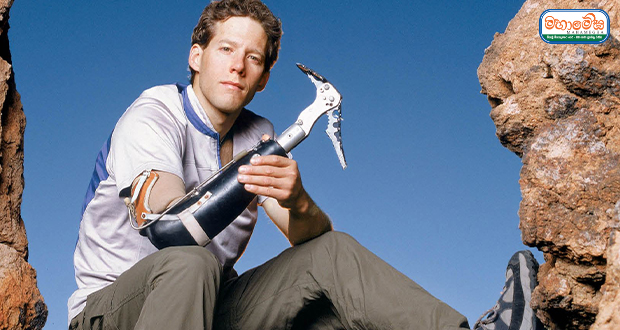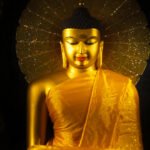In the realm of human survival, few stories match the astonishing feats accomplished when the will to live takes over. One such tale is that of Aron Ralston, a man who faced unimaginable odds and emerged victorious.
Aron Ralston, a mechanical engineer from Denver, Colorado, left his corporate job to pursue his passion for mountaineering. His ambitious goals included conquering Denali in Alaska and scaling all of Colorado’s 59 “fourteeners” alone and during winter. However, his life took a dramatic turn when he became trapped by a boulder while descending into Bluejohn Canyon in southeastern Utah’s Canyonlands National Park. As he descended into Bluejohn Canyon, the boulder dislodged, pinning his right hand against the canyon wall. Trapped 100 feet below ground and 20 miles from help, Ralston faced a dire predicament.
With no means to call for assistance and limited supplies of two burritos, some candy bars, and water, Ralston tried desperately to free his arm. However, his efforts proved futile as the boulder remained immovable. As days passed and his resources dwindled, the severity of his situation became clear.
Dehydrated and desperate, Ralston made a life-altering decision. He resolved to amputate his own arm to escape. Using makeshift tools and summoning unimaginable courage, he broke his bones, fashioned a tourniquet (device that applies pressure to a limb to stop the flow of blood), and with a two-inch knife, began the gruesome process of severing his arm. Enduring excruciating pain, Ralston’s spirit soared. “All the desires, joys, and euphorias of a future life came rushing into me,” he later shared. With each cut, he drew closer to freedom, losing a significant amount of blood along the way.
Driven by an indomitable will to survive, Ralston embarked on an astonishing journey out of the canyon. Climbing, descending cliffs, and navigating treacherous terrain with a single hand, he trekked six grueling miles back to his car, fueled by adrenaline and the desire to live.
In a stroke of fortune, Ralston encountered a Dutch family hiking in the canyon. They offered him sustenance and alerted authorities, leading to his eventual rescue—just four hours after his self-amputation.
Aron Ralston’s remarkable story stands as a testament to the incredible power of the human spirit in the face of insurmountable challenges. His unwavering determination and indomitable will to live carried him through unimaginable pain and hardship, etching his story forever in the annals of survival. However, how long will this triumph endure? Has he truly escaped death once and for all? The perils that lie ahead in his life remain unknown. Moreover, in the context of our samsāric journey, with its endless cycle of rebirth and the frequent experience of dreaded planes of misery, true liberation from such woes becomes an even greater quest.
It is stated in the Dhamma that some individuals are willing to sacrifice their wealth in order to preserve their body organs and limbs. Furthermore, when faced with a life-threatening situation, they display a readiness to relinquish their body organs and limbs, if necessary, to save their own lives. Those who deeply contemplate the teachings of the Dhamma go even further, as they are prepared to surrender not only their wealth, body organs, and limbs, but also their very lives, all in the pursuit of practicing the Dhamma and achieving enlightenment.
How true; in cases where a person’s health is at risk, they might choose to undergo expensive medical treatments, surgeries, or procedures to maintain the functioning of their organs or limbs. These treatments can often come at a significant financial cost, and individuals may be willing to give up their wealth or resources to ensure their physical well-being and quality of life. The value placed on one’s health and the preservation of their body can sometimes outweigh the importance of material wealth.
Then again, like in Aron Ralston’s case in situations where organ failure or severe injury jeopardizes their survival, individuals may opt for organ transplants or amputations to remove damaged or diseased parts of their bodies. This decision is often driven by the instinctual desire to preserve one’s life and overcome the immediate threat to their well-being. The value placed on life itself can surpass attachments to specific body parts, leading individuals to make difficult choices to ensure their continued existence. While such decisions are deeply personal and vary from person to person, the drive to survive can prompt individuals to make extraordinary sacrifices.
Conversely, the wise ones of the world who live by the teachings of the Buddha are willing to give up not only their wealth, body organs, and limbs, but also their very lives, in their pursuit of a lasting solution to the samsāric suffering.
In the time of the Buddha, such a wise person lived in the city of Savatthi. He was a young man, the son of a wealthy Lord. Blessed with a vast fortune of 400 million gold sovereigns, his life seemed filled with opulence and abundance. Yet, beneath the surface of material wealth, a longing for deeper meaning stirred within him. When he encountered the teachings of the Buddha, a profound calling ignited in his heart, urging him to relinquish his worldly attachments and embark on a spiritual quest.
With unwavering determination, the young man boldly renounced his riches, bidding farewell to his family and beloved wife. Embracing the austere life of a monk, he sought solace and serenity along the noble path unveiled by the Buddha. Thus, he became known as Kutumbiyaputta Tissa Thero, residing in a forest near Savatthi, fully immersed in the study and practice of the Dhamma and Vinaya.
Meanwhile, his former wife, now the sole inheritor of his vast fortune, reveled in a life of extravagance and pleasure. She delighted in her newfound freedom, relishing the ability to indulge in the company of any man she desired. However, amidst her carefree existence, a troubling thought crept into her mind. She pondered the possibility of her ex-husband abandoning his monastic vows and returning to lay life. Such an eventuality would shatter her current state of joy and freedom. Determined to prevent this, she hatched a sinister plan.
Contracting a group of ruthless bandits, she furnished them with a detailed description of her former husband’s whereabouts, secluded deep within the forest. Their orders were crystal clear: eliminate him without a trace. Swiftly, the bandits embarked on their mission, closing in on their unsuspecting target, lost in meditation.
Sensing the approach of danger, the astute monk realized his life hung in the balance. Displaying remarkable composure, he turned to address the bandits, his words infused with wisdom and unwavering resolve.
“I entered the monastic life with a singular purpose – to attain enlightenment and free myself from the cycle of suffering. Yet, I humbly admit that I have not yet achieved my goal. I implore you, grant me one more night, until the first rays of tomorrow’s sun, to continue my pursuit of enlightenment. Afterward, you may carry out your intentions as you see fit.”
The bandits, grappling with doubt and suspicion, voiced their concerns. They feared the monk might employ crafty tactics to escape under cover of darkness, betraying their trust. How could they be certain he would not attempt to flee?
With a resolute silence, the monk calmly picked up a sizable rock, positioning himself beneath the shade of a tree, his legs fully extended. Astonishingly, he shattered both his knees with a deliberate strike, leaving the bandits dumbfounded. Radiating unyielding determination, he addressed them once more, his voice brimming with conviction.
“Does this not serve as a testament to my sincerity? With my knees incapacitated you can trust that escape is beyond my reach.”
Rendered speechless by this awe-inspiring act of self-sacrifice, the bandits found themselves unable to muster a response. Their skepticism crumbled in the face of such unwavering resolve.
Bhikkhu Tissa, having intentionally handicapped himself to buy precious time, swiftly redirected his focus to the contemplation of the Dhamma. Throughout the evening and into the night, he endured excruciating pain, suppressing it with unwavering determination. His steadfast commitment to achieving enlightenment before the break of dawn overshadowed the imminent threat of death at the hands of the bandits.
Neither despair nor anger clouded his mind. Not once did he entertain doubts, fearing the possibility of failure.
Against all odds, as the night waned and a new day emerged, Bhikkhu Tissa dispelled the darkness of ignorance, attaining the exalted state of Arahantship. With the first rays of morning casting their gentle glow upon the forest, he faced his demise as an enlightened being, submitting himself to the bandits’ swords. In that profound moment, he transcended the cycle of rebirth, forever liberated from the shackles of suffering. Thus, unlike Aron Ralston, Bhikkhu Tissa found a lasting solution and triumphed over aging, sickness, death and the whole mass of suffering that befalls a person who wanders in samsāra.
We must realize that no amount of wealth or worldly power can free us from the cycle of birth and death. Only the teachings of the Buddha can grant release from this endless wandering. The Dhamma holds the supreme power to guide us toward liberation and alleviate suffering.
Let us humbly seek refuge in the teachings of the Buddha, recognizing their unparalleled significance and the profound transformation they can bring. By nurturing our spiritual growth and cultivating wholesome qualities, we can embark on a journey that leads to true freedom and the highest form of happiness, the supreme bliss of Nibbana.
By a Venerable Monk of the Mahamevnawa Buddhist Monastery














Recent Comments